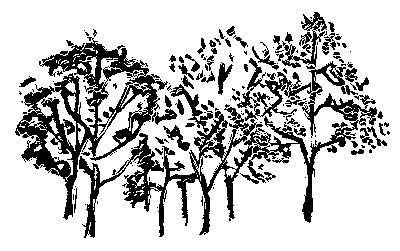 |
| Toki Oshima drawing. |
By Céline Caron
The 68th UN General Assembly declared 2015 the International Year of Soils, and one of the themes for the 2014 permaculture convergence held in July in Frelishburg, Quebec, was “Solutions are in nature.” A good part of the permaculture conference was devoted to soils. Here are the main points of a talk I presented at the permaculture conference.
Soil Has Real Value
Why is the soil more precious than oil? Because we can (and did for thousands of years) live without oil, but now we cannot live without agricultural soil, especially with an expanding population and almost empty seas. Soil is sensitive matter that needs care. Soil is not a factory, a disposal site for toxic wastes, nor a “support” for our cultures; soil is neither dirt nor a huge paved road nor a car park.
Good agricultural soil is rare. Forty percent of Earth’s soils are degraded, so every teaspoon of agricultural soil is precious – crucial for human life, food security, essential ecosystem services, reducing poverty, creating sustainable development and adapting to and mitigating climate change. The soil feeds us and we are responsible for it. If it is not protected by vegetation, it is swept away by wind or washed away by rain.
Fungal Cooperation
Research in the last 50 years has improved our understanding of symbiotic relationships uniting the plant world with associated microbes. This notion, essential to comprehending and using the natural world, is indispensable for its conservation.
Consider fungal mycelium, for example. When soils are treated with care, it continues to develop and function – even in winter – obtaining and retaining water and nutrients. Fungal mycelium is much finer than plant roots and can get water and nutrients from extremely small pores in soils, multiplying by 10 the volume of soil explored by roots! Fungi, more than any other organism, can extract interstitial water and elevate the level of phreatic water (water below the water table), which is excellent for dry areas. Mycelium can also make nutrients with low mobility, such as phosphorus and zinc, more available.
Fungi are also marvelous at degrading toxins and other material detrimental to plants.
Trees rich in associations with mycelium have more energy to develop leaves, stems, flowers and fruits. There are several indications that arbuscular mycorrhizae (in which the fungi penetrate cells) modify the composition of crop plants, including their taste. Ectomycorrhizae (mycorrhizal fungi that remain outside plant cells) intervene in important ways in mineral nutrition of forest trees, including accessing nitrogen, phosphorus and potassium. For example, the extensive mycelium forming in the soils intercepts these nutrients away from the plant roots themselves.
A soil that is alive with fungi smells good. What is alive can transform, aggrade, accumulate, capitalize – the reverse of degradation.
Deciduous Forests as Soil Makers
The soil is the realm of terrestrial life, the interface with the sun. It holds unknown treasures still to be discovered.
Many of these treasures result from the deciduous forest, which can regenerate the fertility of the soil, while anthropocentrism (“bioadversity,” as coined by cardiologist Yves Tessier) destroys it. There is no fundamental difference between the composition of forest, animal or vegetable species; they share, largely, the same sugars, proteins, lipids and physiological mechanisms. The forest and the soil are historical museums, a living landscape. Working with them contributes to the long-time duration of humanity.
A leafy forest returns 70 to 80 percent of its energy to the soil; a lawn or prairie, 10 to 40 percent; asphalt and concrete, zero. Prairie, steppes or pampas soil makes short-term humus, compared with forest soil, which makes long-term humus. (The latter, in relation to ramial chipped wood – wood chips from small branches of deciduous trees – was extensively researched by Laval University by Prof. Gilles Lemieux and later by permaculturist Stefan Sobkowiak of Miracle Farms in Quebec, cultivated since 1997 using permaculture principles.)
Much of today’s soil is yesterday’s forest and tomorrow’s soil. Humans must integrate pedogenesis (the science of soil formation) and especially forest pedogenesis into their methods of cultivating soil and producing food.
Additions to the humic bowl (humus reserves in the soil) constitute new organic and mineral nutrition for the next harvest and cannot be replaced by overdoses of chemicals detrimental to the living soil. Protecting and maintaining stable humus in the soil must be the prime aim of all gardeners, farmers and permaculturists and is necessary for all living beings.
One way to do this is to produce and use ramial chipped wood, which supports fungal growth. (See my article “There Is No Soil Fertility Without a Healthy Forest” in the spring 2007 issue of The MOF&G – at https://www.mofga.org/Publications/MaineOrganicFarmerGardener/Spring2007/RedefiningSoilFertility.) Another is to ensure that forests remain as forests, as much as possible. Yet another is to incorporate deciduous woody plants into foodscapes, as in permaculture.
Much to Protect, Much to Learn
The soil can be compared to the submerged part of an iceberg – or the programming of the subconscious, which controls 95 to 99 percent of our lives. The value of fertile soil that grows the plants that feed us is underestimated, and we still know little about most of its characteristics. We do know that the most beautiful and the tastiest fruits and vegetables come from fertile soil – and we have much more to learn about soil fertility (and the meandering of the subconscious mind).
Resources
Caron, Céline, Gilles Lemieux and Lionel Lachance, 2008, Regenerating Soils with Ramial Chipped Wood, Dept. of Wood and Forest Sciences, Pub. No. 83. Available at www.dirtdoctor.com/view_org_research.php?id=69
Papers by Caron, Lemieux and others relating to soil formation, deciduous forests and ramial chipped wood are posted at https://www.dropbox.com/sh/ysd8l2p3mahz6h0/AABu_r1p3wFGVXIBGhP0Aouwa.
About the Author: Céline Caron, evolutionary ecologist and Earth doctor, lives in Quebec and has written extensively for The MOF&G since 1998 about pedogenesis, ramial chipped wood and deciduous forests.
